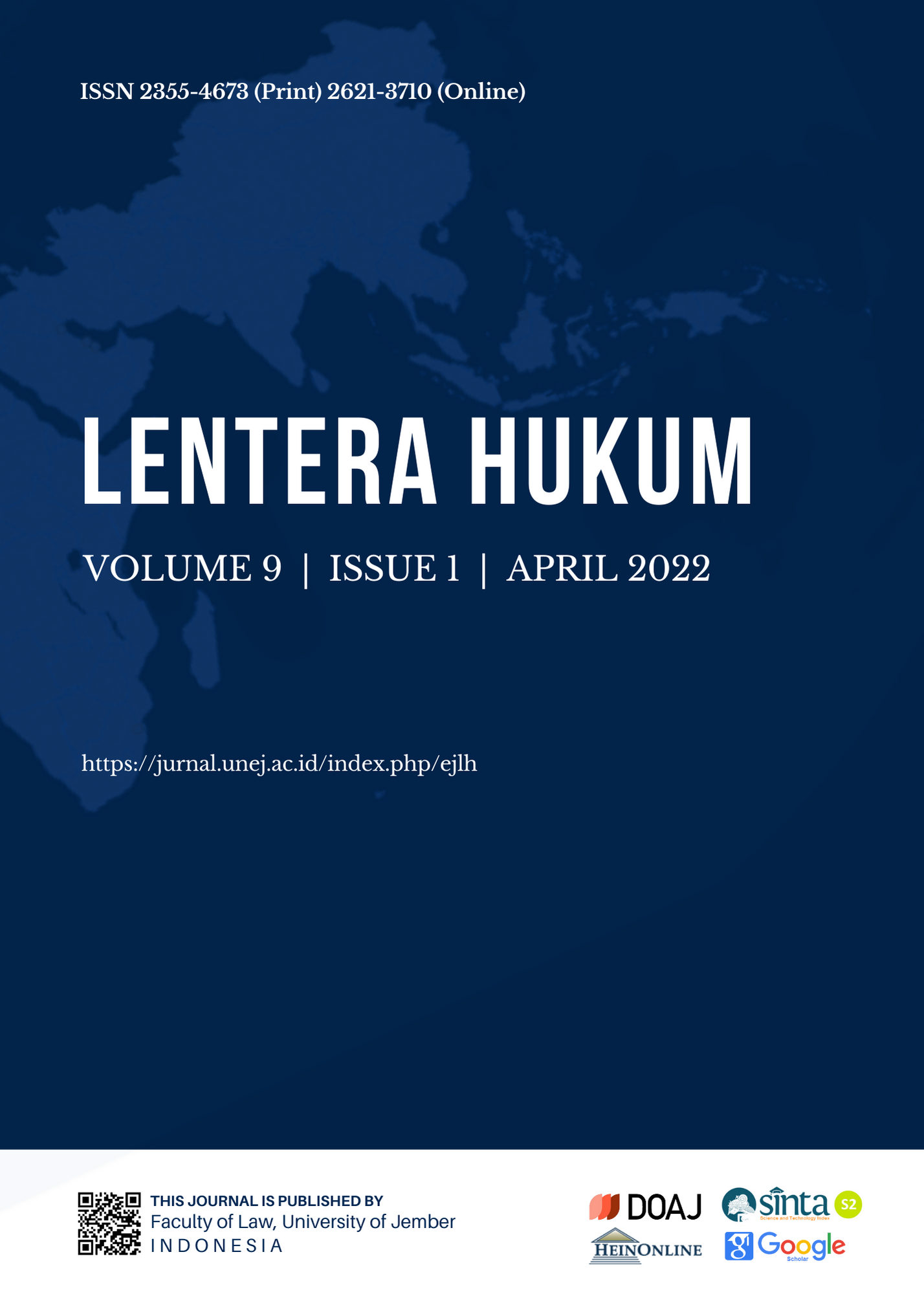Elimination of Child Labor in Vietnam's New Generation of Free Trade Agreements
DOI:
https://doi.org/10.19184/ejlh.v9i1.26026Abstract
As of March 2021, Vietnam negotiated and signed the new generation of Free Trade Agreements (FTAs), consisting of the Comprehensive and Progressive Agreement for Trans-Pacific Partnership (CPTPP), the European-Vietnam Free Trade Agreement (EVFTA), and the Vietnam-Eurasian Economic Union Free Trade Agreement (VN-EAEU FTA). One of the critical issues of these agreements is non-commercial provisions, especially commitments to the elimination of child labor. This study aimed to examine the implementation of the commitment to eliminate child labor in the new generation of FTAs under the principle of pacta sunt servanda and the government's responsibility to comply with international treaties according to the 2013 Constitution. Based on the obligations arising from international treaties, Vietnam must comply with all commitments agreed upon as a state member. As a result, it is necessary to implement suitable solutions to implement these commitments properly, especially the elimination of child labor, according to the three mentioned FTAs. By using comparative and evaluated methods, this study analyzed and commented on the similarities and differences between the Vietnam labor legal system and these three agreements on eliminating child labor. This study indicated relative compatibility between regulations in three FTAs and the Vietnamese legal system. Subsequently, there is a need to improve the effective implementation of these commitments by amending the definition of children, working hours, and classifying violations against the law regarding the employment of workers under 16 years old of coercive labor into the group of crimes and criminal liabilities to commercial legal entities.
Keywords: Child Labor, Free Trade Agreements, Vietnam.
Downloads
References
Amir Radfar et al, “Challenges and perspectives of child labor†(2018) 27:1 Industrial Psychiatry Journal 17–20.
Breen Creighton, “Combating Child Labour: The Role of International Labour Standards†(1997) 18:3 Comparative Labour Law Journal 362–396.
Bui Truong Giang, Towards Vietnam’s FTA strategy: East Asia theoretical and practical basis (Hanoi, Vietnam: Social Science Publishing House, 2010).
Doan Xuan Truong, “Labour Commitment in new-generation FTAs - Opportunities and Challenges for Vietnam†(2017) Journal of Democracy and Law.
Douglas A Irwin, “International Trade Agreementsâ€, Libr Econ Lib, online:<www.econlib.org/library/Enc/InternationalTradeAgreements.html>.
Edo Fernando, “Criminal Law Policy on the Protection of the Marriage of the Underage Children†(2020) 1:1 Indonesian Journal of Law and Society 75–100.
Ha Chinh, “Today, Vietnam - EU officially signed FTA and IPAâ€, VGP News, online: <www.baochinhphu.vn/Kinh-te/Hom-nay-Viet-NamEU-chinh-thuc-ky-ket-FTA-va-IPA/369594.vgp>.
Lars Engen, “Labour Provisions in Asia-Pacific Free Trade Agreements, Ninth Tranche of the Development Account Project†(2017) UN Economic and Social Commission in the Asia Pacific.
Le Thi Thuy Huong, “The possibility of implementing labor commitments in the free trade agreements and some challenges for Vietnam†(2019) 3:124 Vietnam Journal of Legal Sciences 41–49.
Linh Pham, “Vietnam takes benefits from the EVFTA and EVIPAâ€, (2020) online: <https://www.viettonkinconsulting.com/news/vietnam-takes-benefits-from-the-evfta-and-evipa/>.
Maria Anna Corvaglia, “Labour Rights Protection and Its Enforcement under the USMCA: Insights from a Comparative Legal Analysis†(2021) 20:5 World Trade Review 648–667.
Minli Liao & Jun Sung Hong, “Child labor in the People’s Republic of China: An ecological systems analysis†(2011) 54:4 International Social Work 565–579.
Navpreet Kaur & Roger W Byard, “Prevalence and potential consequences of child labour in India and the possible impact of COVID-19 - a contemporary overview†(2021) 61:3 Medicine, Science, and the Law 208–214.
Nehaluddin Ahmad, “Child labour: ground realities of Indian labour laws†(2011) 37:1 Commonwealth Law Bulletin 61–74.
Nguyen Thi Kim Cuc, Commitments on Forced Labor and the Use of Child Labor in New-Generation Free Trade Agreements (LLM Thesis, Ho Chi Minh City University of Law, 2020).
Nguyen Thi Hong Thang, International Law, Foreign Law and Vietnamese Law on the Elimination of Child Labor (LLM Thesis, VNU School of Law, 2012).
Patrick Love & Ralph Lattimore, International Trade: Free, Fair and Open? (Paris: OECD Publishing, 2009).
Philip Alston, “Implementing Children’s Rights: The Case of Child Labour†(1989) 58:1 Nordic Journal of International Law 35–53.
Ranjit Sil, “Child Labour: A Critical Legal Analysis†(2017) 8:1 Indian Journal of Law and Justice 10–28.
Richard E Baldwin, “Multilateralising Regionalism: Spaghetti Bowls as Building Blocs on the Path to Global Free Trade†(2006) 29:11 World Economy Blackwell Publication 1451–1518.
Sanchita Basu Das, “Labour Provisions of the Trans-Pacific Partnership (TPP) and how they may Affect Southeast Asian Countries†(2016) 37 ISEAS Yusof Ishak Institute >.
Sarah A Janzen, “Child labor measurement: Whom should we ask?†(2018) 157:3 International Labour Review 169–191.
Surya Deva, “Child labor: Should companies ‘stand at bay’ or ‘enter the water’?†(2014) 56:2 Journal of Indian Law Institute 143–174.
Terence P Stewart, The GATT Uruguay Round: A Negotiating History 1986- 1992 (Deventer: Kluwer Law and Taxation Publishers, 1993).
Tran Thang Loi, Improving the Law on Juvenile Labor in the Context of International Integration (Ph.D. Thesis, Vietnam National University, 2012).
Vinod K Aggarwal & Charles E Morrison, “Japan’s Approach to APEC and Regime Creation in the Asia Pacific†in Asia Pac Crossroads Regime Creat Future APEC (New York: St Martins Press, 1998).
Vu Cong Giao & Nguyen Hoang Ha, “Prevention and elimination of child labor in international and Vietnamese law†(2017) 11:210 Journal of Jurisprudence 33–45.
Vu Van Ha, “The role of new-generation free trade agreements in international trade†(2017) Journal of Communist.



